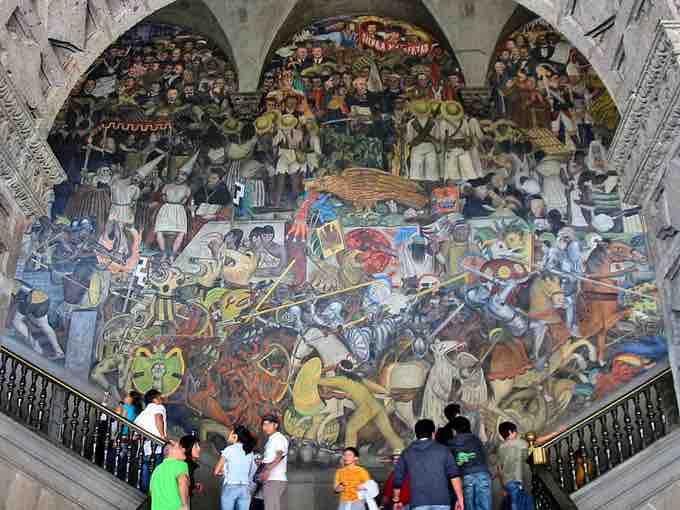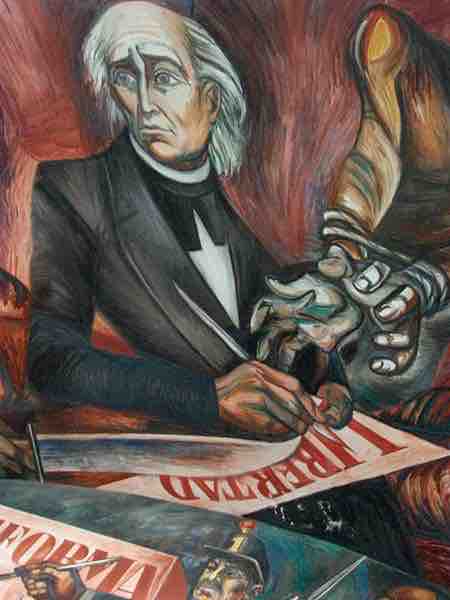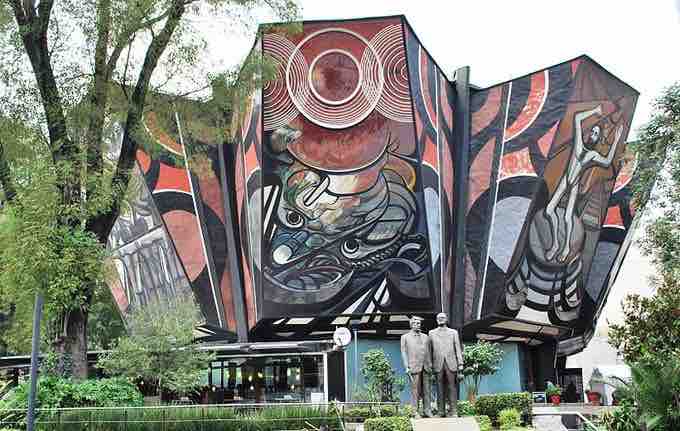The era from 1930-1945 in Mexico is best marked by Mexican muralism. From the 1920s to 1970s a large number of murals with nationalistic, social and political messages were created on public buildings, as part of efforts to reunify the country under the post Mexican Revolution government. Mexican muralism started a tradition which continues to this day in Mexico.
In 1921, after the end of the Mexican Revolution, José Vasconcelos was appointed to head the Secretaría de Educación Pública. At the time, most of the Mexican population was illiterate and the government needed a way to promote the ideals of the Mexican Revolution. Vasconcelos helped establish a government-backed mural program, hiring the country's best artists, for this purpose. Similar to mural use in the pre-Hispanic and colonial periods, the purpose of these murals were not simply aesthetic, but social, to promote certain ideals. These ideals or principles were to glorify the Mexican Revolution and the identity of Mexico as a mestizo nation, with the indigenous promoted as well as the Spanish.
The movement was strongest from the 1920s to the 1950s, which corresponded to the country's transformation from a mostly rural and mostly illiterate society to an industrialized one. While today they are part of Mexico's identity, at the time they were controversial, especially those with socialist messages plastered on centuries-old colonial buildings. One of the basic underpinnings of the nascence of a post revolutionary Mexican art was that it should be public, available to the citizenry and above all not the province of a few wealthy collectors. The great societal upheaval, as well as a lack of relatively wealthy middle class to support the arts, made the concept possible, and on this the painters and the government agreed. Though commissioned by the government, the artists maintained complete freedom of expression; in addition to the original ideas of a reconstructed Mexico and the elevation of Mexico's indigenous and rural identity, many of the muralists included elements of Marxism - especially the struggle of the working class against oppression.
The murals, due to their location and themes, took on a monumental status. Many were painted on the walls of colonial era government buildings. Techniques included the revival of old techniques such as the fresco, painting on freshly plastered walls and encaustic or hot wax painting . Others used mosaics and high fire ceramics, as well as metal parts, and layers of cement.
Los Tres Grandes
The three most influential muralists from the 20th century are Diego Rivera, José Clemente Orozco, and David Siqueiros, often referred to as “los tres grandes” (the three great ones). They are known to have believed that art was the highest form of human expression and a key force in social revolution. Their work defined the movement, creating a mythology around the Mexican Revolution and the Mexican people, and promoted Marxist ideals, which are still influential to this day. At the time the works were painted, they also served as a form of catharsis over what the country had endured during the war. However, the three were quite different in their artistic expression. Rivera’s works were utopian and idealist, Orozco’s were critical and pessimistic and the most radical were those of Siqueiros, heavily focused on a scientific future. The differences among the three have much to do with how each experienced the Mexican Revolution. Rivera was in Europe the entire time and did not fight. He never depicted the horrors of the war but what he perceived to be the social benefits from it. The other two did fight, and both expressed the horrors of war in their work.
Diego Rivera
Of the three artists, Rivera was the most traditional in terms of painting styles, drawing heavily from European modernism. His themes were Mexican, often scenes of everyday life and images of ancient Mexico. He originally painted this in bright colors in the European style, but modified it to more earthy tones to imitate indigenous murals. His greatest contribution is the promotion of Mexico's indigenous past into how many people both inside and outside of the country view it .

Mural in the main stairwell of the National Palace by Diego Rivera
A leader in Mexican muralism, much of Rivera's work was utopian and idealist.
Jose Clemente Orozco
Orozco also began with a European style of expression. However, his art developed into an angry denunciation of oppression especially by those he considered to be an evil and brutal ruling class. His work was somber and dire, with emphasis on human suffering and fear of the technology of the future. Unlike other artists, Orozco never glorified the Mexican Revolution, having fought in it, but rather depicted the horrors of this war. This caused many of his murals to be heavily criticized and even defaced .

"La gran legislación revolucionaria mexicana y la abolición de la esclavitud". Mural by José Clemente Orozco painted in Guadalajara, Jalisco, Mexico between 1948 and 1949.
Orozco, one of the three great muralists of the 20th century, painted murals that were more critical and pessimistic that his peers.
David Alfaro Siqueiros
Siqueiros was the youngest and most radical of the three, having joined the Venustiano Carranza army when it was 18 and experienced the Revolution from the front lines. Although all three were communists, Siqueiros was the most dedicated, with his painting filled with portrayals of the proletarian masses. His work is also characterized with rapid, sweeping, bold lines and the use of modern enamels, machinery and other elements related to technology. His radical politics made him unwelcome in Mexico and the United States, so he did much of his work in South America. His masterpiece is considered to be the Polyforum Cultural Siqueiros, located in Mexico City .

Polyforum Cultural Siqueiros in Mexico City
Siquieros is known for his radical politics and murals, characterized by rapid, sweeping, bold lines. The Polyform Cultural Siqueiros is considered his masterpiece.
Mexican muralism brought mural painting back to the forefront of Western art in the 20th century with its influence spreading abroad, especially promoting the idea of mural painting as a form of promoting social and political ideas. The concept of mural as political message was transplanted to the United States, especially in the former Mexican territory of the Southwest, and served as inspiration to the later Chicano Mural Movement.